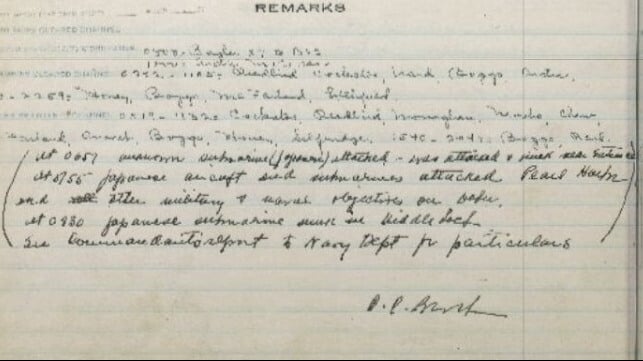Lost and Found: Navy Yard Logbook From the Pearl Harbor Attack

By miraculous coincidence, conservators at the U.S. National Archives have recovered the logbook for Pearl Harbor Naval Base for the period before and after the Japanese attack on December 7, 1941. It is the only record of its kind from the "date which will live infamy," and it was nearly lost to a trash bin before finding its way into private hands, according to the previous owners.
The logbook covers the status of vessels in the yard during the period from March 1941 to June 1942, a period of extremely rapid and momentous events. During the time period when the first entries, the U.S. was on a peacetime footing and was in diplomatic talks with Japan; nine months later, Japanese forces attacked Pearl Harbor and the U.S. entered the war; and by the end of the logbook, just seven months further on, the U.S. Navy won strategic victories at the Battle of the Coral Sea and the Battle of Midway, and was gearing up to retake the Solomon Islands.
The log nearly didn't make it. According to Michael William Bonds, who inherited it from his mother Oretta Kanady, the recordbook somehow ended up at Norton Air Force Base in California, where Kanady worked as a civilian employee in the 1970s. Bonds told the Washington Post that Kanady found the logbook in a trash bin and asked if she could take it home. It wasn't classified, and she received permission. Bonds took possession of it when she passed in 2000, and has had it in storage ever since. Only recently did he realize what it was, and its exceptional historical value.
The record documents moments of tragedy and triumph for Pacific Fleet. It notes the untimely arrival of USS Oklahoma and USS Arizona on December 5, just in time for their destruction at the hands of Japanese pilots two days later. On the page for December 7, it details the time of arrival of the first Japanese aircraft, and the time of arrival and departure of Navy warships in response to the strike (top). On the morning of December 8, as salvors dealt with the aftermath of the attack, the log noted that the capsized hull of the battleship USS Utah "appears to be drifting out into channel," recommending a tug to be sent to secure the wreck.
It also shows the Pearl Harbor yard's essential work in repairing Navy warships after the Japanese attack, putting cruisers and destroyers back in the fight after severe damage. Within six months, the yard had taken in and redelivered the damaged battleships Pennsylvania, Maryland, and Tennessee; cruisers Honolulu, Helena, and Raleigh; destroyers Helm and Shaw; and three auxiliaries, all fully repaired or patched up for transit for permanent repairs.
